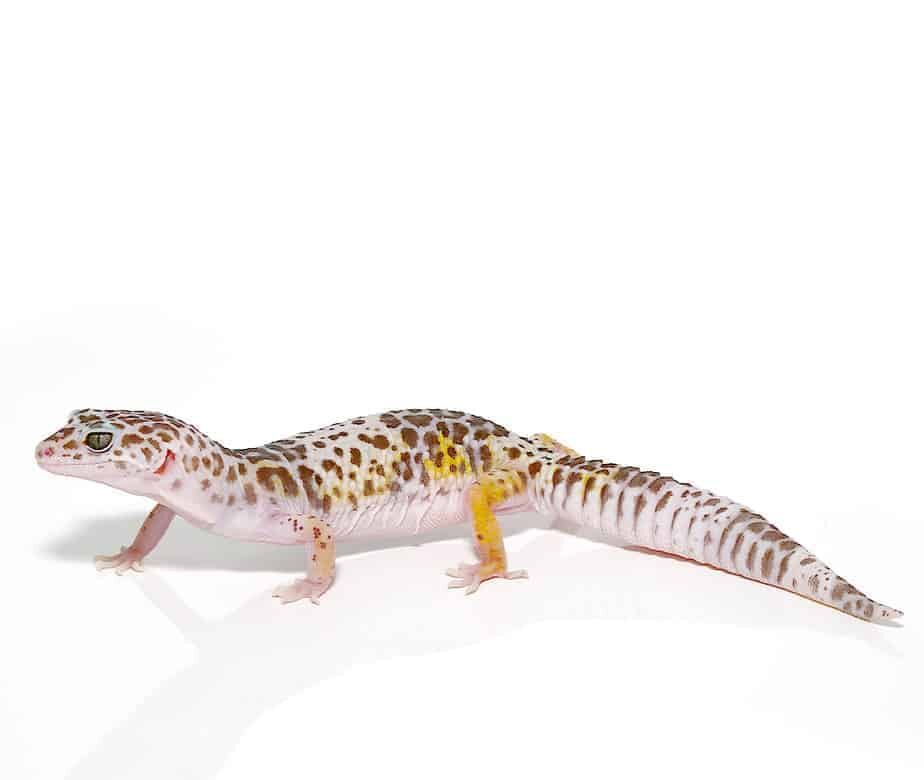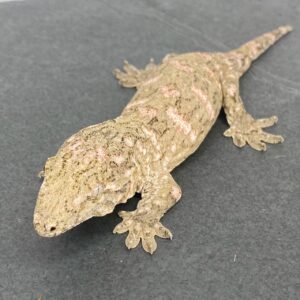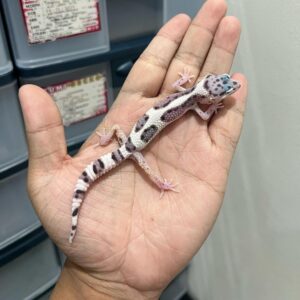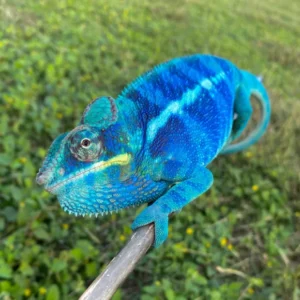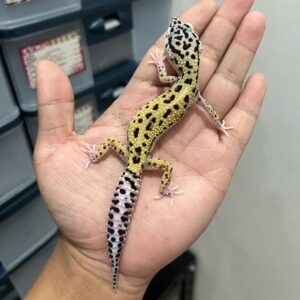West Indian Leopard Gecko For Sale
$399.99
WE HAVE A WEST INDIAN LEOPARD GECKO FOR SALE. HERE ARE SOME HIGHLIGHTS:
- Eublepharis fuscus
- Captive Bred
- Female
- Roughly 34 Grams In Weight
- Approximately 5 Inches In Length
- Adults Can Reach Up To 7 – 9 Inches In Length From Head To Tail
- Feeding On Calcium Dusted Crickets & Mealworms
Description
The West Indian Leopard Gecko, scientifically known as Eublepharis macularius, is a captivating reptile species that has garnered attention among herpetology enthusiasts and pet owners alike. Recognized for its striking appearance and distinctive behavior, this gecko is a member of the Eublepharidae family, which encompasses a variety of gecko species known for their unique eyelids—a trait not commonly found in other gecko families.
Native to the rocky, arid regions of the West Indies, the West Indian Leopard Gecko thrives in environments that offer both warmth and an abundance of hiding spots. Its natural habitat typically includes crevices and burrows, where it can escape the extreme daytime temperatures and come out to hunt during the cooler evenings. This nocturnal lifestyle is a key characteristic of the species, allowing it to conserve energy and avoid predators.
One of the most notable features of the West Indian Leopard Gecko is its vibrant and diverse coloration. These geckos display a range of patterns, from bold spots to intricate stripes, in hues that can vary from bright yellows and oranges to more subdued browns and grays. This variation not only adds to their visual appeal but also plays a role in camouflage, helping them blend into their natural surroundings.
Behaviorally, the West Indian Leopard Gecko is known for its docile and relatively low-maintenance nature, making it a popular choice for reptile aficionados. It is primarily insectivorous, feeding on a diet of crickets, mealworms, and other small invertebrates. The gecko’s keen hunting skills are complemented by its ability to store fat in its tail, which serves as a crucial energy reserve during periods when food is scarce.
In summary, the West Indian Leopard Gecko is a remarkable reptile that combines aesthetic beauty with intriguing behavioral traits. Understanding its scientific classification, natural habitat, and general behavior provides a foundational appreciation of this species, setting the stage for a deeper exploration into its care and conservation.
Physical Characteristics and Morphology
The West Indian Leopard Gecko is a fascinating reptile, renowned for its distinct physical attributes. Generally, these geckos exhibit a moderate size, with adults typically reaching lengths of 8 to 12 inches from snout to tail. Their bodies are robust yet agile, designed perfectly for their terrestrial habitat.
One of the most striking features of the West Indian Leopard Gecko is its vivid coloration. These geckos display a variety of hues, ranging from vibrant yellows and oranges to more muted browns and grays. This coloration often includes an array of spots and stripes, resembling a leopard’s pattern, which provides excellent camouflage against predators. The skin texture of these geckos is another distinguishing feature; it is generally smooth but can have a slightly bumpy feel due to small, raised scales.
Distinctive markings also play a crucial role in identifying the West Indian Leopard Gecko. Juveniles often exhibit brighter and more pronounced patterns, which can fade slightly as they mature. However, the unique arrangement of spots and stripes remains a key identifier throughout their lifespan. This visual diversity not only aids in individual identification but also contributes to their popularity among reptile enthusiasts.
Sexual dimorphism is present in this species, albeit subtly. Males tend to be slightly larger and more robust than females, with broader heads and thicker necks. Additionally, mature males often exhibit pre-anal pores and hemipenal bulges, which are absent in females. These physical differences, though minor, are essential for breeders and researchers in accurately sexing the geckos.
Understanding the physical characteristics and morphology of the West Indian Leopard Gecko is vital for proper identification and care. Whether observing these reptiles in the wild or as pets, recognizing their unique features ensures a deeper appreciation and more effective management of this captivating species.
Natural Habitat and Distribution
The West Indian Leopard Gecko, scientifically known as Eublepharis macularius, is native to the diverse and picturesque regions of the West Indies. This gecko thrives in a variety of environments, from rocky outcrops and arid regions to forested areas, demonstrating a remarkable adaptability to different ecological niches. These geckos are particularly fond of areas that offer ample hiding spots, such as crevices in rocks and dense vegetation, which provide both protection from predators and optimal conditions for thermoregulation.
In terms of geographical distribution, the West Indian Leopard Gecko is predominantly found across several islands in the West Indies. Notable locations include the islands of Hispaniola, Puerto Rico, and Jamaica, where they have established significant populations. Each of these islands offers a unique set of environmental conditions that contribute to the gecko’s ability to thrive. For instance, the arid regions of Hispaniola provide a stark contrast to the more humid, forested areas of Puerto Rico, yet both environments support healthy gecko populations.
Furthermore, the West Indian Leopard Gecko exhibits some degree of variation across its range, leading to the identification of several subspecies. These subspecies have adapted to their specific local environments, resulting in slight morphological and behavioral differences. For example, geckos from more arid regions may display lighter coloration as an adaptation to their surroundings, whereas those from forested areas might have darker, more camouflaged patterns.
Understanding the natural habitat and distribution of the West Indian Leopard Gecko is crucial for conservation efforts and captive breeding programs. By replicating the gecko’s natural environment, enthusiasts and researchers can ensure the well-being and sustainability of this fascinating species. As urbanization and habitat destruction continue to pose threats, preserving the natural habitats of these geckos becomes increasingly important for their survival.
Diet and Feeding Habits
The West Indian Leopard Gecko is an insectivorous creature, primarily consuming a variety of insects and small invertebrates in its natural habitat. In the wild, these geckos exhibit opportunistic feeding behavior, preying on whatever insects are available. Common food sources include crickets, beetles, spiders, and other small arthropods. This diverse diet ensures that they receive a balanced intake of proteins and essential nutrients necessary for their growth and survival.
In captivity, it is crucial to replicate their natural diet as closely as possible to maintain their health and well-being. The primary food sources for a captive West Indian Leopard Gecko should consist of live insects such as crickets, mealworms, and waxworms. These insects not only provide the necessary nutrients but also encourage the gecko’s natural hunting instincts. It is advisable to dust the insects with calcium and vitamin D3 supplements to prevent deficiencies, especially since captive geckos may not have access to the same variety of natural food sources as their wild counterparts.
Feeding schedules for West Indian Leopard Geckos can vary depending on their age and size. Juvenile geckos, which have higher growth rates, should be fed daily to ensure they receive adequate nutrition. As they mature, feeding can be reduced to every other day. It’s important to monitor their weight and adjust feeding frequencies accordingly. Overfeeding can lead to obesity, while underfeeding can result in malnutrition and stunted growth.
Providing a shallow dish of fresh water is essential, as hydration plays a critical role in their overall health. Additionally, offering occasional treats such as small pieces of fruit can enrich their diet, although these should not constitute a significant portion of their food intake. By adhering to these guidelines, you can ensure that your West Indian Leopard Gecko thrives in captivity, maintaining a healthy and balanced diet that mimics their natural feeding habits.
Behavior and Social Structure
The West Indian Leopard Gecko exhibits distinctive behavioral patterns that are essential for potential pet owners to understand. Primarily nocturnal, these geckos are most active during the night, engaging in hunting and social interactions. During the day, they typically seek refuge in shaded or hidden areas to avoid excessive heat and predation, making it crucial to provide adequate hiding spots in their enclosures.
Interaction among West Indian Leopard Geckos can vary significantly depending on their environment and individual temperaments. In the wild, they are generally solitary creatures, coming together primarily for mating purposes. However, in captivity, they can exhibit a range of social behaviors. Some geckos might tolerate the presence of others, while others may display territorial aggression. It’s important for pet owners to monitor their geckos closely when housing multiple individuals together. Signs of stress or conflict, such as biting or persistent chasing, should prompt immediate action to separate the geckos to prevent injury.
Territorial behavior is another significant aspect of the West Indian Leopard Gecko’s social structure. Males, in particular, are known to be highly territorial and may defend their space aggressively against other males. This territoriality can manifest in various ways, including specific posturing, vocalizations, and physical confrontations. Understanding these behaviors can help pet owners manage their geckos’ environments more effectively, ensuring that each gecko has adequate space to reduce stress and potential conflicts.
Unique behavioral traits of the West Indian Leopard Gecko include their method of communication and interaction. They use a combination of body language, vocal sounds, and chemical cues to convey messages to one another. For instance, tail waving can signal different intentions, from courtship to a warning of potential threat. Recognizing these subtle cues can enhance the caretaking experience, enabling owners to respond appropriately to their geckos’ needs.
By understanding the behavior and social structure of the West Indian Leopard Gecko, pet owners can create a more enriching and harmonious environment. This knowledge not only fosters better welfare for the geckos but also enhances the overall experience of keeping these fascinating reptiles as pets.
Reproduction and Lifespan
The reproductive biology of the West Indian Leopard Gecko is a fascinating aspect of their life cycle. These geckos reach sexual maturity at around 12 to 18 months of age. During the mating season, which typically occurs in the warmer months, males exhibit distinctive behaviors such as tail waving and vocalizations to attract females. Once a female is receptive, mating will occur, followed by egg-laying.
Females can lay multiple clutches of eggs throughout the breeding season, with each clutch typically consisting of two eggs. The eggs are laid in moist, hidden areas to ensure proper incubation. The incubation period for West Indian Leopard Gecko eggs ranges from 45 to 60 days, depending on the temperature and humidity levels. Higher temperatures usually result in shorter incubation periods but can also influence the sex ratio of the hatchlings.
In their natural habitat, the lifespan of West Indian Leopard Geckos typically ranges from 10 to 15 years. However, in captivity, with proper care, they can live up to 20 years or more. Factors that influence their longevity include diet, habitat conditions, and overall health care. Providing a balanced diet, maintaining appropriate temperature and humidity levels, and regular veterinary check-ups are essential for extending the lifespan of captive geckos.
For those interested in breeding West Indian Leopard Geckos in captivity, several considerations are crucial. Ensuring that both the male and female are healthy and of appropriate age is the first step. Creating a suitable breeding environment with adequate hiding spots and optimal temperature and humidity levels is also important. After egg-laying, it is imperative to carefully monitor the incubation conditions to ensure successful hatching.
Breeding geckos can be a rewarding experience, but it requires dedication and attention to detail. By understanding the reproductive biology and providing the necessary care, enthusiasts can contribute to the conservation and propagation of the West Indian Leopard Gecko species.
Health and Common Diseases
The West Indian Leopard Gecko, like other reptiles, can suffer from a variety of health issues and diseases. Recognizing the signs of illness early is crucial for ensuring timely and effective treatment. Common symptoms to watch for include lethargy, loss of appetite, abnormal feces, swelling, and changes in skin color or texture. Observing these signs can help in early detection and treatment of potential health problems.
One of the most common health issues in West Indian Leopard Geckos is metabolic bone disease (MBD), which often results from calcium deficiency. Symptoms of MBD include soft or deformed bones, difficulty moving, and tremors. Ensuring a diet rich in calcium and proper UVB lighting can help prevent this debilitating condition.
Another frequent ailment is respiratory infections, usually caused by suboptimal temperature or humidity levels in the gecko’s habitat. Signs of a respiratory infection include wheezing, nasal discharge, and open-mouth breathing. Maintaining proper environmental conditions and seeking veterinary care promptly can mitigate these risks.
Parasitic infections, both internal and external, are also common. Internal parasites can cause weight loss, diarrhea, and a general decline in health, while external parasites, such as mites, can lead to skin irritation and secondary infections. Regular fecal examinations and maintaining a clean habitat are essential preventive measures.
Preventive care plays a significant role in the overall health of West Indian Leopard Geckos. Regular veterinary check-ups are vital for monitoring their health and catching issues early. A well-balanced diet, proper lighting, and maintaining ideal temperature and humidity levels are key aspects of good husbandry practices that can prevent many common diseases.
Finally, stress can also negatively impact the health of these geckos. Minimizing handling, providing adequate hiding spaces, and ensuring a stable environment can contribute to their well-being. By adhering to these guidelines and being vigilant about their health, keepers can ensure their West Indian Leopard Geckos lead healthy and fulfilling lives.
Conservation Status and Efforts
The West Indian Leopard Gecko, a species native to the Caribbean region, currently faces a range of threats that jeopardize its survival. Habitat destruction is one of the primary challenges. Urban development, agriculture, and deforestation have led to significant loss of natural habitats, which are crucial for the gecko’s survival. Additionally, predation by invasive species such as rats and feral cats further exacerbates the decline in their population.
Another pressing concern is climate change. Rising temperatures and altered weather patterns disrupt the delicate ecosystems these geckos depend on. Changes in precipitation levels can affect the availability of water and food sources, making it increasingly difficult for the West Indian Leopard Gecko to thrive. The cumulative impact of these threats has led to the species being classified as vulnerable or endangered in various parts of its range.
In response to these challenges, several conservation efforts are underway. Local and international organizations are working diligently to protect the West Indian Leopard Gecko. Habitat restoration projects aim to rehabilitate and preserve natural environments, providing a safe haven for the species. Legal protections have also been established in some areas to restrict activities that could further harm their habitats.
Moreover, captive breeding programs have been initiated to bolster population numbers. These programs not only aim to increase the number of geckos but also to reintroduce them into their natural habitats. Education and awareness campaigns play a crucial role in conservation efforts. By informing the public about the plight of the West Indian Leopard Gecko, these campaigns foster a sense of responsibility and encourage community involvement in conservation activities.
Individuals can contribute to the protection of the West Indian Leopard Gecko in several ways. Supporting conservation organizations through donations or volunteering can make a significant impact. Advocating for environmental protection policies and participating in local conservation initiatives are also vital actions that can help safeguard this unique species. Through collective efforts, it is possible to ensure the survival of the West Indian Leopard Gecko for future generations.


